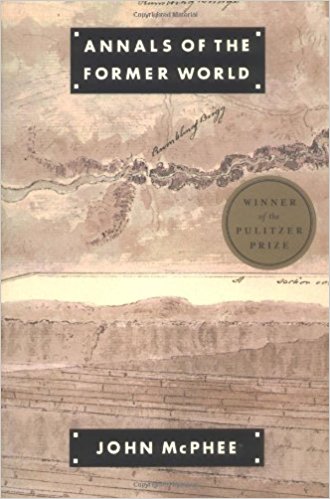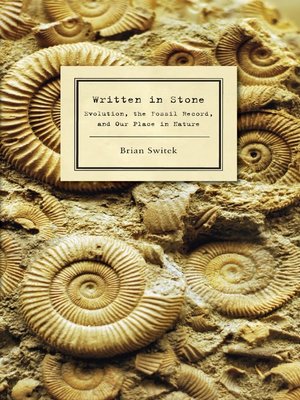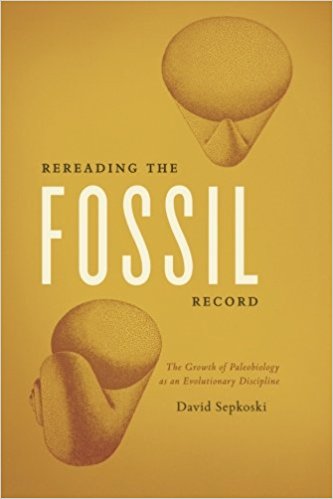Derek Turner writes . . .
"Written in Stone"
There is a long tradition of thinking of the fossil record as a text or a book that scientists can read or interpret. Indeed, the term “fossil record” itself already connotes something written down. A record is something you read, maybe something you find in an archive, or something you file away. This textual metaphor is so deeply entrenched that it seems natural and ineluctable. It doesn’t seem like a metaphor at all. But like all metaphors, it has advantages and disadvantages. It opens up certain lines of inquiry while obscuring other questions from view. And like any metaphor, it’s optional. Like poets, scientists often need to select the right metaphor for the job.
Metaphor is everywhere in science, from natural selection to the big bang, from genetic transcription and translation to the greenhouse effect, from string theory to ecological niches. Indeed, one fascinating way to begin engaging with science philosophically is to try to think critically about the metaphors that scientists use. How and why did those metaphors become established, and what are their cognitive costs and benefits?
The book metaphor shows up all over the place in paleontology: for example, in the title of David Sepkoski’s definitive account of the paleobiological revolution, Rereading the Fossil Record.[1] Martin Rudwick was playing with the same metaphor when he titled his classic book on the history of paleontology, The Meaning of Fossils.[2] Rudwick was treating fossils as a text whose meaning has to be discerned by a reader or interpreter. Another favorite book of mine is the lesser known Written in Stone, a geological history of New England, written by Chet Raymo and Maureen Raymo.[3] Brian Switek has a book with the same title.[4] (Incidentally, the popular expression, “That’s not written in stone,” seems to be an allusion to the ten commandments, which were written in stone. See Exodus 24:12. Switek and the Raymos are perhaps playing with that association, too.) Another salient example is John McPhee’s masterpiece, Annals of the Former World, which recounts a road trip across I-80 from east to west, in the company of various geologists who help read those annals at roadcuts along the way.[5] Technically, ‘prehistory’ includes everything that happened before the invention of writing, before the beginning of record keeping. So It seems natural to think of geology and paleontology as a matter of reading the fossil record, or what’s written in stone, or the annals that predate writing. The very concept of the fossil record is a textual metaphor. But we don't think of it that way because we've forgotten the concept's history.
The Author of Nature
The notion that rocks and fossils form a written record is continuous with the old idea that God has left us with two books to read, and from which to learn about him: scripture on the one hand, and the book of nature on the other. The “two books” metaphor captures the idea that revealed religion and natural religion offer different sources of evidence concerning God. The idea that nature is a book shows up, among other places, in Galileo’s writing. And the idea that Earth’s history is “written in stone” is closely connected to this two books view: The ten commandments are the paradigm case of revealed theology, whereas the crust of the earth is a source for natural theology. Stone is the shared medium.
The traditional view was that God authored the “book of nature.” Indeed, it was not unusual, in the context of natural theology, to refer to God as the “author of nature.” For example, Joseph Butler uses the phrase in his work, The Analogy of Religion, Natural and Revealed (1736).[6] And in Part 2 of Hume’s Dialogues Concerning Natural Religion (1779), Cleanthes—the character who stands in for traditional natural theology—uses the phrase when formulating his first version of the argument from design:
Since the effects resemble each other, we are led to infer by all the rules of analogy that the causes are also alike, and that the author of nature is somewhat similar to the mind of man.[7]
Cleanthes leans so heavily on the book metaphor that he actually uses it to frame one interesting alternative version of the design argument. He first asks us to indulge in the fantasy that books can propagate themselves the way organisms do.
Well, now: suppose you enter your library, the shelves of which are full of natural volumes, containing the most refined reasoning and the most exquisite beauty; could you possibly open one of them and doubt that its original cause bore the strongest analogy to mind and intelligence?[8]
Books require authors, and even if those books are miraculously able to reproduce themselves as organisms do, there must have been some original author responsible for the text. So it would seem that organisms require authors, too: "The anatomy of an animal affords many stronger instances of design than the perusal of Livy or Tacitus," says Cleanthes. Fascinatingly, this "irregular" version of the argument from design leaves Hume's skeptical character, Philo, "a little embarrassed and confounded"--at least, that's what we're told by the youthful observer, Pamphilus. Hume quite deliberately and playfully has Cleanthes take the book metaphor as far as it will go, spinning it into an amped up version of the design argument. Forget about finding a watch while crossing the heath; in Hume's hands, the argument is about texts. The readability of the book of nature points to the existence of an author.
Of course, paleontologists and geologists today need not share Butler's or Cleanthes's commitment to the argument from design, or have any theistic commitments at all. But if we think about the fossil record as something to be read, that naturally invites the question: who wrote it? This is an example of how metaphor can direct our questioning. It’s also an interesting case of how our ways of thinking and talking about science sometimes have theological overtones that persist long after many people stop caring much about the theology. The idea that there are laws of nature is another theological vestige. Laws point to some sort of lawgiver. It’s almost that the metaphor becomes so familiar to us that we stop worrying much about its implications.
Ripping the Pages Out
Darwin, in the Origin of Species, very explicitly compares the geological record to a book, but he adds a new twist, reworking the old metaphor in his own subtly subversive way:
For my part, following out Lyell’s metaphor, I look at the natural geological record, as a history of the world imperfectly kept, and written in a changing dialect; of this history we possess the last volume alone, relating only two or three countries; of this volume, only here and there a short chapter has been preserved; and of each page, only here and there a few lines.[9]
Darwin here emphasizes the incompleteness of the fossil record, a move which among other things, seemed to suggest that paleontology has little to teach us about evolution. How much could we possibly learn from such an incomplete text? It also pulled the rug out from under critics who might have wondered where all the transitional fossils were hiding. Others have pointed out how important this passage was for the subsequent development of paleontology. The relative degree of (in)completeness of the fossil record remains a subject of intense investigation by paleontologists—and intense discussion among us philosophers. The book metaphor itself is less often remarked upon.
There is a critique of natural theology implicit in Darwin’s adaptation of the book metaphor to make the point about geological incompleteness. If God wrote the book, then why would God rip the pages out? That would be like dictating the ten commandments to Moses and then scratching a few of them out.
The book metaphor is extremely useful in some ways—for example, in helping us to frame questions about incompleteness. But one problem with metaphors is that they can also limit you to seeing things in certain ways, when other ways of seeing are possible. We should give ourselves permission to play with other ways of thinking about fossils and our relationship to them. It’s only by trying out alternative metaphors that we can really appreciate how the entrenched ones structure our thinking.
Fossils as Tools
Why not think of fossils as tools for investigating the deep past? Instead of thinking of fossils as lying around waiting to be read or interpreted, we could think of them as tools that scientists might use for certain investigative purposes. On this way of thinking, fossils are part of a larger scientific toolkit that includes a lot of other things: computer models, databases, CT scanners, all the tools of the preparation lab, statistical techniques for analyzing large datasets, living model organisms, DNA and proteins from living organisms, and much else. Instead of asking, “What inferences can we draw from this fossil evidence,” we might ask, “What can we do with these fossils, perhaps in conjunction with other implements, to learn more about the past?” The distinction is subtle, and I do not want to claim that we should stop using the traditional book metaphor. But the tool metaphor can open up new ways of thinking about paleontology.
The book metaphor lends itself quite well to traditional theory-centric philosophy of science. According to this traditional picture, science is really all about testing theories and hypotheses. Science is successful when you have theories and hypotheses that get at the truth, or when they do a good job predicting and explaining the evidence. It then falls to philosophers of science to help clarify the relevant notions of evidential confirmation and explanation. The book metaphor invites us to think of fossils—the fossil record, written in stone—as the evidence base against which we might test different theories and hypotheses about the past. Interestingly, it also assimilates the study of prehistory to history, treating the crust of the earth as a kind of testimony about the past.
The tool metaphor is more in keeping with what some philosophers of science call “the turn toward scientific practice.” Philosophers of science who advocate for the “practice turn” tend to think of science more as an investigative activity, using various tools to learn about the world. Philosophers working in this vein have tended to focus more on experimental practice, arguing that scientific experiments are not always about testing rival theories. Thinking of fossils as tools might be a step toward a more practice-oriented philosophy of paleontology. This is not to say that theory is not important, but only that we get a different view of science if we resolve not to privilege theory quite so much.
The tool metaphor isn’t perfect—none is—but it might be a better tool for some purposes than the book metaphor.
[1] D. Sepkoski, Rereading the Fossil Record: The Growth of Paleobiology as an Evolutionary Discipline. University of Chicago Press, 2012.
[2] M.J.S. Rudwick, The Meaning of Fossils: Episodes in the History of Palaeontology. University of Chicago Press, 1972.
[3] C. Raymo and M. Raymo, Written in Stone: A Geological History of the Northeastern United States. Black Dome Press, 2001.
[4] B. Switek, Written in Stone: Evolution, the Fossil Record, and our Place in Nature. Bellevue Library Press, 2010.
[5] J. McPhee, Annals of the Former World. Farrar, Strauss & Giroux, 2000.
[6] J. Butler, Analogy of Religion, Natural and Revealed. New York: E.P. Dutton & Co., 1906. For just one example of Butler’s use of the phrase “author of nature,” see “Of a future life,” p. 13. The full text is available online here.
[7] D. Hume, Dialogues Concerning Natural Religion, 2nd edition, edited by R. Popkin, Hackett Publications, 1988, p. 15.
[8] D. Hume, Dialogues Concerning Natural Religion, p. 24. Another fascinating example of what you might call a textual version of the argument from design occurs in Richard Taylor, Metaphysics, 4th edition, Prentice-Hall, 1992, Ch. 11.
[9] C. Darwin, On the Origin of Species. A facsimile of the first edition, Harvard University Press, 1964, pp. 310-311.




